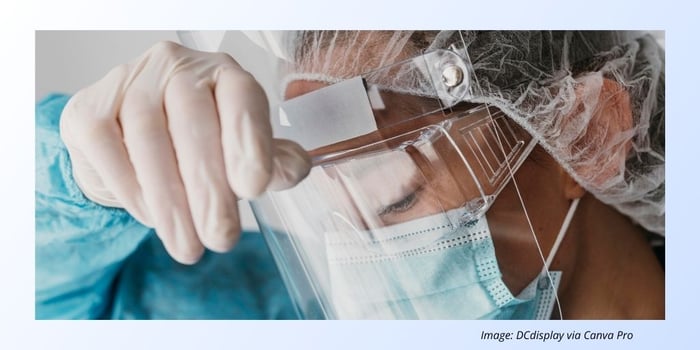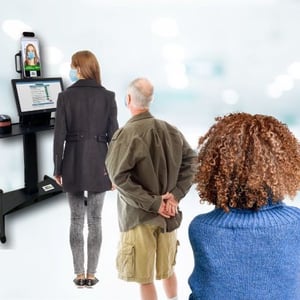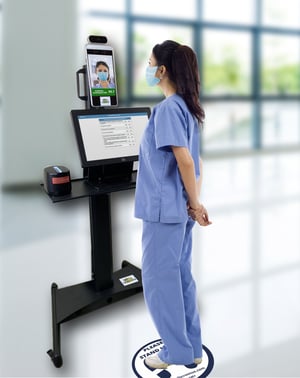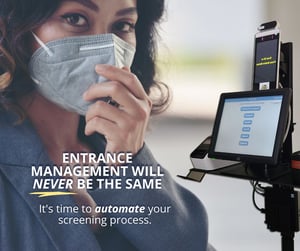COVID-19 on the Rise Again
In a world affected by the ongoing COVID issues, hospitals have been at the forefront of battling the virus and caring for those affected.
"It is a fact. COVID cases are up again. The CDC is describing it as an uptick after a long period of declining rates. There is also a new omicron variant on the rise."
- NPR: How to navigate the rise in COVID cases this summer

Increase in Hospitalizations
With hospitalizations rising by over 12% in the past week alone, the need for permanent stringent measures to prevent further spread has never been more evident. While it is a COVID uptick today, inevitably, it will be something else tomorrow.
The Solution: Hospitals Need Comprehensive Entrance Screening
Incorporating routine screening of everyone entering a hospital into an overall entrance management system should be a permanent safety process for every hospital.
Pre-COVID, anyone with a temperature of 102-degrees and a cough could get in to see Grandma!
Bluntly put, there is no justification for a hospital to allow ANY non-patient to enter the building sick!!!!
Today We'll Look at Benefits & Concerns of Entrance Screening
This blog delves into the reasons behind implementing a comprehensive entrance screening process as a safety strategy by examining its benefits and addressing potential concerns.
Quick Links:
Jump to a particular section of the blog post:
- The PROS of Comprehensive Entrance Screening
- The CONS of Comprehensive Entrance Screening
- The PROS of Including Employees in Screening
- The CONS of Including Employees in Screening
- Key Takeaway
- Take Action Now: Book a Meeting
The Imperative for Permanent Comprehensive Screening
The Pros:
The Significance of Comprehensive Screening
1. Mitigates Transmission Risk: Rigorous screening at hospital entrances serves as the initial defense line. Identifying individuals who may be ill aids in preventing the introduction and spread of infections within the hospital setting.
2. Safeguards Vulnerable Patients: Hospitals house individuals with compromised immune systems and underlying health conditions. Thorough screening ensures those vulnerable patients' safety by minimizing the risk of exposure to contagious individuals, reducing the likelihood of severe illness or complications.
3. Safer Environment: By proactively screening all individuals, hospitals can maintain a safer environment for patients and staff. This approach helps prevent outbreaks among healthcare workers, ensuring uninterrupted medical services.
4. Boosts Public Confidence: Implementing comprehensive screening measures not only enhances public trust in the hospital's dedication to health and safety protocols but also demonstrates a proactive approach towards protecting the well-being of patients, staff, and the community. By implementing thorough entrance screening, hospitals send a clear message that they prioritize the health and safety of everyone who enters their premises.
5. Creates a Halo Effect: Implementing comprehensive screening creates a ripple effect that extends far beyond the immediate benefits of identifying sick people before they enter the hospital. Once established and consistently implemented, this proactive approach not only deters visitors and staff from attempting to enter when unwell but also fosters a culture of responsibility and accountability.
The ripple effect also extends to the mindset of individuals. Once people become accustomed to the routine of comprehensive screening, they become more aware of their own health and the potential risks they may pose to others. This heightened awareness can lead to proactive measures, such as seeking medical attention when experiencing symptoms or staying home when feeling unwell.
The Cons:
Navigating Potential Concerns of Comprehensive Screening
1. Potential Delays: Thorough screening might lead to slight delays in the entry process, especially during peak hours.
HOWEVER: The benefits of preventing disease transmission far outweigh the minor inconvenience of a brief wait. Additionally automated visitor management systems with built in capability make the process seamless.
2. Resource Allocation: Introducing comprehensive screening systems requires an investment in technology, personnel, and training.
HOWEVER: While there might be initial costs, the long-term savings in terms of reduced infections and improved patient outcomes can be substantial. I many situations staffing is reduced with the deployment of self service options.
3. Accuracy: Screening methods like temperature checks are not foolproof and can yield false positives or negatives.
HOWEVER: With the advancements in technology and the implementation of wellness attestations, the accuracy of these measures has been greatly enhanced.
The Inclusion of Employees in Screening:
Thorough screening should not be limited to visitors and patients; including employees and providers is equally essential in containing any spread of infection.
The Pros of Including Employees in Screening:
1. Preventing Workplace Outbreaks: Healthcare professionals interact closely with vulnerable patients. Screening employees helps identify potential carriers, preventing the inadvertent spread of diseases among patients and colleagues.
2. Demonstrating Commitment: When employees undergo the same screening process as visitors, it showcases the hospital's commitment to the health and safety of all stakeholders. This fosters a sense of unity and collective responsibility.
3. Identifying Asymptomatic Cases: Some employees and providers might be asymptomatic carriers of the virus. Regular screening can detect asymptomatic cases, ensuring they receive proper medical attention and minimizing further spread.
The Cons of Including Employees in Screening:
1. Operational Challenges: Screening a large number of employees can initially strain resources and cause minor operational disruptions.
HOWEVER: As screening processes become routine, these challenges can be efficiently managed. A well-designed visitor and entrance management system will include a mobile app option for employees to use en route to work that additionally streamlines the process.
2. Privacy Concerns: Employee screening can raise privacy concerns.
HOWEVER: To address this, hospitals should communicate clearly about the purpose and measures in place to safeguard sensitive information.
3. Logistical Complexity: Hospitals often have shift-based staff with varying schedules.
HOWEVER: Coordinating the screening process to cover all employees can be logistically challenging but is feasible with proper planning.
Key Takeaway:
Comprehensive and Permanent Screening at Your Entrances is a Necessary Safety Measure
The necessity for comprehensive screening of everyone entering hospitals, including employees and providers, is evident in the current climate AND BEYOND.
With hospitalizations on the rise and the ongoing threat of COVID-19, these measures are crucial for the safety of patients, staff, providers and the community at large.
The benefits from comprehensive entrance screening of preventing disease transmission, protecting vulnerable populations, and preserving healthcare services are undeniable.
Proactive Safety Measures = Comprehensive Entrance Screening
Hospitals must take a proactive stance in safeguarding the health and safety of their patients, employees, and providers.
By embracing comprehensive entrance screening and wellness attestations, healthcare institutions can contribute significantly to curbing the spread of infections and continuing to provide essential medical services without compromising quality outcomes and safety.
Take Action Now:
If you’re ready to explore how you can improve safety in your hospital, with comprehensive visitor & entrance screening, book a meeting with us below: